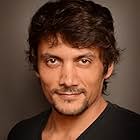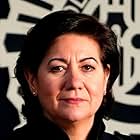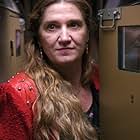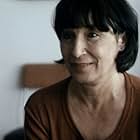Photos
César Cadaval
- Manuel Machado
- (as Cesar Cadaval)
Storyline
Featured review
The story starts in 1956 with an aging Francisca Sánchez del Pozo ¨Paca¨ is living in Navalsaúl where receives a visit from two writers . The marriage of writers tries to convince her to donate the contents of the trunk where she keeps Ruben's memories to the state . From now on
and by means of a long flashback is developed the enjoyable love story between Rubén Dario and Paca Félix , including biographic remarks . As Rubén García Sarmiento (January 18, 1867 - February 6, 1916) was a Nicaraguan poet who initiated the Spanish-language literary movement known as modernismo (modernism) that flourished at the end of the 19th century. Darío had a great and lasting influence on 20th-century Spanish-language literature and journalism. He has been praised as the "Prince of Castilian Letters" and undisputed father of the modernismo literary movement.
This mini-series was co-produced by RTVE and La Cometa TV , dealing with the love story between famous writer Rubén Dario and the Spanish Francisca Sánchez . The movie boasts a great cast , such as Irene Escolar (Un otoño en Berlin , La Corona partida) , Daniel Holguin (El Consejero) and appearances from notorious secondaries such as Ana Wagener (Biutiful) compellingly playing Emilia Parardo Bazán , Israel Elejalde (El Hombre de las Mil Caras) , Petra Martinez (Mientras duermes) and Luisa Martin (Servir y proteger , De Boca en Boca) and Paca's mother. In La princesa Paca (2017) shows up famous writers at the time, such as : Valle-Inclán , Emilia Pardo Bazán , Miguel de Unamuno , Pío Baroja , Manuel Machado , Antonio Machado , among others.
Based on Rubén Dario life , and adding more biographic elements : Darío arrived in Spain committed to sending four chronicles per month to La Nación about the prevalent mood in the Spanish nation after the defeat it suffered to the United States of America, and the loss of its colonial possessions; Cuba, Puerto Rico, the Philippines, and Guam. These chronicles would end up being compiled in a book that was published in 1901, titled España Contemporánea. Crónicas y retratos literarios. In the writings, he expresses his profound sympathy towards Spain, and his confidence in Spain's revival, despite the state of despair he observed. In Spain, Darío won the admiration of a group of young poets who defended Modernism (a literary movement that was not absolutely accepted by the most established writers, especially those belonging to the Real Academia Española) . Among these young modernists there were a few writers that would later have important roles in Spanish literature such as Juan Ramón Jiménez, Ramón María del Valle-Inclán and Jacinto Benavente, and some that were prevalent in their time, like Francisco Villaespesa, Mariano Miguel de Val, director of the magazine Ateneo, and Emilio Carrere. In 1899, Rubén Darío, who was still legally married to Rosario Murillo, met Francisca Sánchez del Pozo in the Casa de Campo of Madrid. Francisca was from Navalsauz in the province of Ávila and would be his companion through the last years of his life. In April 1900, Darío visited Paris for a second time, commissioned by La Nación to cover the Exposition Universelle that took place that year in the French capital city. His chronicles about this topic would later be compiled in the book Peregrinaciones. During the first years of the 20th century, Darío lived in Paris, where in 1901 published the second edition of Prosas profanas. That same year Francisca and Rubén had a daughter. After giving birth she traveled to Paris to reunite with him, leaving the baby girl in the care of her grandparents. The girl died of smallpox during this period, without her father ever meeting her. In March 1903 he was appointed as consul by Nicaragua. His second child by Francisca was born in April 1903, but also died at a very young age. During those years, Darío traveled through Europe, visiting, among other countries, the United Kingdom, Belgium, Germany, and Italy. In 1905, he went to Spain as a member of a committee named by the Nicaraguan government whose task was to resolve a territorial dispute with Honduras. That year he published, in Madrid, the third of his most important poetry books, Cantos de vida y esperanza, los cisnes y otros poemas, edited by Juan Ramón Jiménez. Some of his most memorable poems came to light in 1905, like "Salutación del optimista" and "A Roosevelt", in which he extols Hispanic traits in the face of the threat of United States imperialism. The second poem was directed at then president of the United States, Theodore Roosevelt. Later on , he managed to be named resident minister in Madrid for the Nicaraguan government of José Santos Zelaya. He had economic problems since his limited budget barely allowed him to meet all of his delegation's expenses, and he had much economic difficulty while he was Nicaraguan ambassador. He managed to get by, partly with his salary from La Nación and partly with the help of his friend and director of the magazine Ateneo, Mariano Miguel de Val, who, while the economic situation was at its toughest, offered himself as secretary to the Nicaraguan delegation at no charge and offered his house, number 27 Serrano street, to serve as the diplomatic quarters of the Nicaraguan delegation. When Zelaya was overthrown, and then Darío was forced to resign his diplomatic post on February 25, 1909.
This mini-series was co-produced by RTVE and La Cometa TV , dealing with the love story between famous writer Rubén Dario and the Spanish Francisca Sánchez . The movie boasts a great cast , such as Irene Escolar (Un otoño en Berlin , La Corona partida) , Daniel Holguin (El Consejero) and appearances from notorious secondaries such as Ana Wagener (Biutiful) compellingly playing Emilia Parardo Bazán , Israel Elejalde (El Hombre de las Mil Caras) , Petra Martinez (Mientras duermes) and Luisa Martin (Servir y proteger , De Boca en Boca) and Paca's mother. In La princesa Paca (2017) shows up famous writers at the time, such as : Valle-Inclán , Emilia Pardo Bazán , Miguel de Unamuno , Pío Baroja , Manuel Machado , Antonio Machado , among others.
Based on Rubén Dario life , and adding more biographic elements : Darío arrived in Spain committed to sending four chronicles per month to La Nación about the prevalent mood in the Spanish nation after the defeat it suffered to the United States of America, and the loss of its colonial possessions; Cuba, Puerto Rico, the Philippines, and Guam. These chronicles would end up being compiled in a book that was published in 1901, titled España Contemporánea. Crónicas y retratos literarios. In the writings, he expresses his profound sympathy towards Spain, and his confidence in Spain's revival, despite the state of despair he observed. In Spain, Darío won the admiration of a group of young poets who defended Modernism (a literary movement that was not absolutely accepted by the most established writers, especially those belonging to the Real Academia Española) . Among these young modernists there were a few writers that would later have important roles in Spanish literature such as Juan Ramón Jiménez, Ramón María del Valle-Inclán and Jacinto Benavente, and some that were prevalent in their time, like Francisco Villaespesa, Mariano Miguel de Val, director of the magazine Ateneo, and Emilio Carrere. In 1899, Rubén Darío, who was still legally married to Rosario Murillo, met Francisca Sánchez del Pozo in the Casa de Campo of Madrid. Francisca was from Navalsauz in the province of Ávila and would be his companion through the last years of his life. In April 1900, Darío visited Paris for a second time, commissioned by La Nación to cover the Exposition Universelle that took place that year in the French capital city. His chronicles about this topic would later be compiled in the book Peregrinaciones. During the first years of the 20th century, Darío lived in Paris, where in 1901 published the second edition of Prosas profanas. That same year Francisca and Rubén had a daughter. After giving birth she traveled to Paris to reunite with him, leaving the baby girl in the care of her grandparents. The girl died of smallpox during this period, without her father ever meeting her. In March 1903 he was appointed as consul by Nicaragua. His second child by Francisca was born in April 1903, but also died at a very young age. During those years, Darío traveled through Europe, visiting, among other countries, the United Kingdom, Belgium, Germany, and Italy. In 1905, he went to Spain as a member of a committee named by the Nicaraguan government whose task was to resolve a territorial dispute with Honduras. That year he published, in Madrid, the third of his most important poetry books, Cantos de vida y esperanza, los cisnes y otros poemas, edited by Juan Ramón Jiménez. Some of his most memorable poems came to light in 1905, like "Salutación del optimista" and "A Roosevelt", in which he extols Hispanic traits in the face of the threat of United States imperialism. The second poem was directed at then president of the United States, Theodore Roosevelt. Later on , he managed to be named resident minister in Madrid for the Nicaraguan government of José Santos Zelaya. He had economic problems since his limited budget barely allowed him to meet all of his delegation's expenses, and he had much economic difficulty while he was Nicaraguan ambassador. He managed to get by, partly with his salary from La Nación and partly with the help of his friend and director of the magazine Ateneo, Mariano Miguel de Val, who, while the economic situation was at its toughest, offered himself as secretary to the Nicaraguan delegation at no charge and offered his house, number 27 Serrano street, to serve as the diplomatic quarters of the Nicaraguan delegation. When Zelaya was overthrown, and then Darío was forced to resign his diplomatic post on February 25, 1909.
Details
- Release date
- Country of origin
- Language
- Also known as
- Princezná Paca
- Production company
- See more company credits at IMDbPro
Contribute to this page
Suggest an edit or add missing content













